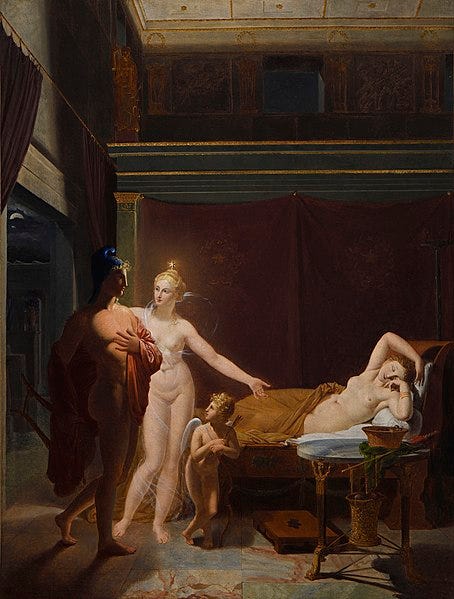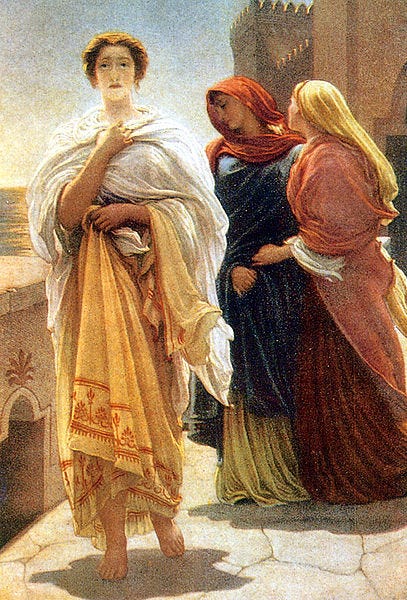This post is a basic introduction to reading Iliad 3. Here is a link to the overview of book 2 and another to the plan in general. As a reminder, these posts will remain free, but there is an option to be a financial supporter. All proceeds from the substack are donated to classics adjacent non-profits on a monthly basis.
Book 3 of the Iliad provides another great example of Homeric style: first, while the catalogue of Greeks and Trojans in book 2 set us up to expect the beginning of actual fighting, the book delays it further by introducing a duel between Menelaos and Paris. Second, the book introduces motifs or scenes that would not at all be appropriate in a logical sense to a war that has been ongoing for 10 years: it features an all-or-nothing duel between Menelaos and Paris (that fails), an introduction to some of the Greek leaders from the Trojan perspective, narrated by Helen (the so-called Teikhoskopia, or “viewing from the walls”), an introduction to Priam and Antenor, the elders of the Trojan people, a somewhat contentious exchange between Helen and Aphrodite about comforting Paris, and the subsequent, somewhat awkward sex-scene.

In my view on the reading and teaching and my general sense of the five major themes to follow in the Iliad book 3 emphasizes most epic’s dependence and divergence from narrative traditions, although politics and family & friends aren’t far behind. There’s a bit about the relationship of gods and humans in the exchange between Helen and Aphrodite (which could be taken psychoanalytically as an individual struggling with lust) that is crucial for larger questions about divine plan(s) and human agency.
But the dominant theme of the Iliad’s third book is the past. If the Iliad were prestige television like The Last of Us or, probably more appropriately, Band Of Brothers, book 3 would be a flashback episode. Epic narrative, however, seems to accommodate flashbacks primarily in micronarratives (cf. scenes like those of Philoktetes and Protesilaos in the Catalogue of Ships) and character speech, with the exception of a massive stylized flashback like that of the end of book 2. In a way, the Catalogue of book 2 sets us up for thinking about the beginning of the war and questions of how we got here and who is involved.
There have been scholars who have seen book 2 as a pastiche of scenes from different epics or poems edited cleverly together. I think that this is partly right: it brings together images and ideas from a different timeline in the war and makes them somehow make sense to be told in this particular tale. The ordering is clever, but I don’t think we need to imagine the major scenes cut whole from other poems and stitched together like this. Instead, I think we can imagine popular song traditions and melodies deftly integrated into a much larger symphony.
Malcolm Davies (2007, 146) writes: “
It is well known that the Iliad's poet ingeniously constructed entire episodes in his composition by transferring them from portions of the Trojan War that precede his actual plot. Thus, the Catalogue of Ships, the Teichoscopia, the duel of Menelaus and Paris, the love-making of the latter with Helen, and the truce and building of the Achaeans' defensive wall and trench, all owe their existence to this device, and have inspired various qualms as to the propriety of their featuring at so late a stage as the War's ninth year”
But what does all this mean for our understanding of this poem? There’s a neat bit near the beginning of the poem where we get a bit of a metapoetic reflection of epic composition, centered on Helen in particular.
Homer, Il. 3.121-128
Iris then went as a messenger to white-armed Helen,
Looking for all the world like the wife of Antênor’s son, sister-in-law,
The wife of the lord of Helikaon, Antênor’s son, Laodikê,
The most beautiful of Priam’s daughters,
Who found her at home. She was weaving on her great loom,
A double-folded garment, in which she was embroidering
The many struggles of the horse-taming Trojans and the bronze-girded Achaeans,
All the things they had suffered for her at Ares’ hands.”῏Ιρις δ’ αὖθ’ ῾Ελένῃ λευκωλένῳ ἄγγελος ἦλθεν
εἰδομένη γαλόῳ ᾿Αντηνορίδαο δάμαρτι,
τὴν ᾿Αντηνορίδης εἶχε κρείων ῾Ελικάων
Λαοδίκην Πριάμοιο θυγατρῶν εἶδος ἀρίστην.
τὴν δ’ εὗρ’ ἐν μεγάρῳ· ἣ δὲ μέγαν ἱστὸν ὕφαινε
δίπλακα πορφυρέην, πολέας δ’ ἐνέπασσεν ἀέθλους
Τρώων θ’ ἱπποδάμων καὶ ᾿Αχαιῶν χαλκοχιτώνων,
οὕς ἑθεν εἵνεκ’ ἔπασχον ὑπ’ ῎Αρηος παλαμάων·
Helen is creating an image here and it is poetic, although she does not sing her narrative as other female figures do (as noted by a scholion). (For more on women and weaving in Homer, see this post and the included bibliography).
Schol T ad. Il 3.125b ex: “She does not sing like Kirke and Kalypso, for they live without suffering and calmly.”
ex. ἡ δὲ μέγαν ἱστὸν ὕφαινε: οὐκ ᾄδει ὡς Κίρκη καὶ Καλυψώ· ἀπαθῶς γὰρ ἐκεῖναι καὶ ἠρέμα ζῶσαι.
Helen is, as we will see from her comments in book 6, almost uniquely concerned about her future reception. But here she is taken for standing in a position similar to the Homeric narrator.
Schol. bT ad Il. 3.126-127: “The poet has shaped here a worthy archetype for his own poetry. Perhaps on this [s?]he is trying to show to those who see it the violence of the Trojans and the just strength of the Greeks.”
ex. πολέας δ’ ἐνέπασσεν ἀέθλους<—χαλκοχιτώνων>: ἀξιόχρεων ἀρχέτυπον ἀνέπλασεν ὁ ποιητὴς τῆς ἰδίας ποιήσεως. ἴσως δὲ τούτῳ τοῖς ὁρῶσιν ἐπειρᾶτο δεικνύναι τὴν Τρώων βίαν καὶ τὴν ῾Ελλήνων δικαίαν ἰσχύν.
This is, of course, not a new or unpopular view, as clarified by George A. Kennedy (1986, 5):
“both the web itself and the subjects it depicts are in process. Helen is somehow like the bard, whose poem an audience is hearing or reading, though she is working in a visual medium, rather than in oral verse. Critics have reasonably concluded that her action should be regarded as somehow reflective of the poetic process. This view was already adopted in medieval scholia on line 3.126-7 which comment "the poet has formed a worthy archetype of his own poiesis."
What I think is important here, is that before venturing to retell tales that belong in a flashback, the Homeric narrator provides this metapoetic breadcrumb for us to consider. As José González shows, following the work of Greg Nagy, in The Epic Rhapsode and His Craft: Homeric Performance in a Diachronic Perspective, stitching or weaving poetry together is a functional metaphor for what ancient audiences conceived of Homeric poets as doing. Derek Collins provides a nice bit from the scholia to Pindar in his Master of the Game:
οἱ δέ φασι τῆς ῾Ομήρου ποιήσεως μὴ ὑφ᾽ ἓν συνηγμένης, σποράδην δὲ ἄλλως καὶ κατὰ υέρη διῃρημένης, ὁπότε ῥαψῳδοῖεν αὐτην, εἱρυῶ τινι καὶ ῥαφῇ παραπλήσιον ποιεῖν, εἰς ἓν αὐτὴν ἄγοντας.
Some say that, since the poetry of Homer had not been brought together in one collection, and since it was otherwise scattered and separated into parts, whenever they would sing it rhapsodically they would do something similar to sequencing or sewing, producing it into one thing.
And this may help us understand the nature of Homeric poetry is, if we trust the etymology of Homer as one who fits “‘fits together’ pieces of poetry that are made ready to be parts of an integrated whole just as a master carpenter or joiner ‘fits together’ or ‘joins’ pieces of wood that are made ready to be parts of a chariot wheel.”
But, as Andrew Ford argues, ancient rhapsodes didn’t merely edit pre-existing material: there’s good evidence for the term applying to new compositions, “remixes” (my words), and genres other than epic. So, part of the trickiness of book 3, is weighing how Homer engages with ‘traditional material’, whether or not the Iliadic appropriation of scenes from earlier in the war is more homage or revision, and how the details help to set us up for what comes later.
Helen, in this scene, is presented as creating a synoptic visual narrative of everything everyone had suffered on her part. And this anticipates what she does later on: she selects details in response to her audience’s questions to set the scene for the action to come. She tells us about herself, and the heroes and also provides a vehicle for characterizing Priam, Antenor, and Paris too. By engaging in narrative thus just as the epic begins the violence again, the Iliad tips its own hand: it is fitting together the major motifs of the Trojan War and creating a synoptic account of all the suffering in a singular creation of its own. Helen is our guide, but Homer’s creation.
Some guiding questions for book 3
What are the characterizing functions of the teikhoskopia (the “viewing from the walls”)? Whom do we hear about? What do we learn?
Why do we have a duel between Menelaos and Paris in the 9th year of the war? How does the outcome drive the plot of the Iliad?
What is the characterization of Helen in this book and how does it relate to the Iliad and the larger Trojan War?
Brief Bibliography on Helen and the Teikhoskopia
n.b this is not an exhaustive bibliography. If you’d like anything else included, please let me know. There will be a second post this week on Helen.
BLONDELL, RUBY. “‘Bitch That I Am’: Self-Blame and Self-Assertion in the Iliad.” Transactions of the American Philological Association (1974-) 140, no. 1 (2010): 1–32. http://www.jstor.org/stable/40652048.
Blondell, Ruby. “REFRACTIONS OF HOMER’S HELEN IN ARCHAIC LYRIC.” The American Journal of Philology 131, no. 3 (2010): 349–91. http://www.jstor.org/stable/40983352.
Davies, Malcolm. “The Hero and His Arms.” Greece & Rome, vol. 54, no. 2, 2007, pp. 145–55. JSTOR, http://www.jstor.org/stable/20204187.
Ebbot, Mary. 1999. “The Wrath of Helen: Self-Blame and Nemesis in the Iliad,” 3–20 in Nine Essays on Homer, ed. Carlisle and Levaniouk, Lanham, Maryland: Rowman and Littlefield, 1999.
Elmer, David F. “Helen Epigrammatopoios.” Classical Antiquity 24, no. 1 (2005): 1–39. https://doi.org/10.1525/ca.2005.24.1.1.
Jamison, Stephanie W. “Draupadí on the Walls of Troy: ‘Iliad’ 3 from an Indic Perspective.” Classical Antiquity 13, no. 1 (1994): 5–16. https://doi.org/10.2307/25011002.
KENNEDY, GEORGE A. “HELEN’S WEB UNRAVELED.” Arethusa, vol. 19, no. 1, 1986, pp. 5–14. JSTOR, http://www.jstor.org/stable/44578384.
Lesser, Rachel H. "Female Ethics and Epic Rivalry: Helen in the Iliad and Penelope in the Odyssey." American Journal of Philology 140, no. 2 (2019): 189-226. https://doi.org/10.1353/ajp.2019.0013.
Roisman, Hanna M. “Helen in the ‘Iliad’ ‘Causa Belli’ and Victim of War: From Silent Weaver to Public Speaker.” The American Journal of Philology 127, no. 1 (2006): 1–36. http://www.jstor.org/stable/3804922.
Rynearson, Nicholas C. "Helen, Achilles and the Psuchê: Superlative Beauty and Value in the Iliad." Intertexts 17 (2013): 3-21. https://doi.org/10.1353/itx.2013.0001.
Scodel, Ruth. "Pseudo-Intimacy and the Prior Knowledge of the Homeric Audience *." Arethusa 30, no. 2 (1997): 201-219. https://doi.org/10.1353/are.1997.0010.
Sheppard, J. T. “Helen with Priam (Homer’s ‘Iliad’, III).” Greece & Rome 3, no. 7 (1933): 31–37. http://www.jstor.org/stable/641466.
Warwick, Celsiana. "The Maternal Warrior: Gender and Kleos in the Iliad." American Journal of Philology 140, no. 1 (2019): 1-28. https://doi.org/10.1353/ajp.2019.0001.
Worman, Nancy. “The Body as Argument: Helen in Four Greek Texts.” Classical Antiquity 16, no. 1 (1997): 151–203. https://doi.org/10.2307/25011057.





I recommend “The Wrath of Helen: Self-Blame and Nemesis in the Iliad,” 3–20 in Nine Essays on Homer, ed. Carlisle and Levaniouk, Lanham, Maryland: Rowman and Littlefield, 1999.
There was also this wonderful collaboration with great contributions in both places: https://classical-inquiries.chs.harvard.edu/introduction-to-helen-and-her-eidolon/